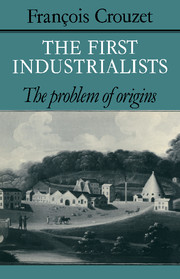9 - The Self-Made Man Again?
Published online by Cambridge University Press: 25 October 2011
Summary
Undoubtedly, a large majority of industrialists came from the middle class, which had a high index of representation, as it did not make up more than 30% of England's population in the early nineteenth century. However, the middle class – or rather classes – included not only many different occupations but also a wide range of ranks in society: there was a large gap between a banker or a West India merchant on the one hand and a small manufacturer or a yeoman on the other. So, after concentrating on occupations, it is necessary to attempt an analysis which will be more ‘social’, distributing industrialists according to their wealth and status.
This is extremely difficult. First, there was much diversity, not only from one industry to another but also within one particular industry from one town or district to another. Second, there is no information on such matters for many people in the samples. So the only method (though admittedly an unsatisfactory one) is to infer the social class of most individuals from their occupation. In Tables 3,5 and 7 the various middle-class occupational groups have been distributed into a middle class (in the early-nineteenth-century sense) and a ‘lower middle class’, according to assumptions about the wealth, income and status appurtenant to those groups. A bias in favour of the upper stratum is likely, because all merchants in inland trade and still more all manufacturers (Groups K and M) were not well-to-do, ‘middle-class’, men, and some may have operated fairly small businesses.
- Type
- Chapter
- Information
- The First IndustrialistsThe Problem of Origins, pp. 126 - 144Publisher: Cambridge University PressPrint publication year: 1985



